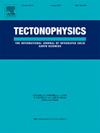普纳-纳西克德干堤坝的构造地貌演化:从结构和尺寸缩放中获得的启示
IF 2.7
3区 地球科学
Q2 GEOCHEMISTRY & GEOPHYSICS
引用次数: 0
摘要
印度半岛德干大陆洪积玄武岩的特点是广泛的玄武岩喷发,并以三个壮观独特的堤坝群为装饰:普纳-纳西克堤坝群、纳尔马达-塔皮堤坝群和西部海岸堤坝群。我们的研究区域是普纳-纳西克堤坝群,该堤坝群有 465 个可标注的堤坝。这些堤坝的走向各不相同,主要走向为 N101°,长度从不足 1 千米到 64 千米不等。这些堤坝具有大量节理,偶尔含有充满石英和方解石等次生矿物的囊泡。主岩是各种较古老的德干岩流的风化玄武岩。在这项研究中,我们利用堤坝的长宽比(长度/厚度)计算了岩浆超压和岩浆腔深度。根据主岩玄武岩的平均杨氏模量(Eavg,7.5 GPa),估计岩浆源的平均深度为 13 千米。此外,我们还比较了推断的普纳-纳西克和纳尔马达-塔皮堤群(包括德干洪水玄武岩省的南杜尔巴尔-杜勒和帕赫马希堤群)的岩浆源深度。我们的研究结果表明,与其他堤群相比,普纳-纳西克堤群的岩浆室源深度更大。普纳-纳西克堤坝群走向分布的变化可归因于多种因素,包括岩浆腔较大、浅岩浆腔产生的局部应力场或堤坝形成过程中构造应力场(N-S 和 E-W 向延伸)的叠加。这与人们普遍认为堤坝仅与留尼汪热点的中心结构有关的观点形成了鲜明对比。本文章由计算机程序翻译,如有差异,请以英文原文为准。
Tectonomagmatic evolution of Pune – Nasik Deccan Dykes: Insights from structure and dimension scaling
The Deccan Continental Flood Basalt of the Indian Peninsula is characterized by extensive basaltic eruptions ornamented with three spectacular distinct dyke swarms: the Pune – Nasik, Narmada – Tapi, and Western Coastal dyke swarms. Our study area is the Pune – Nasik dyke swarm, which has ∼465 mappable dykes. These dykes exhibit different orientations with a predominant trend of N101° and vary in length from less than 1 km to ∼64 km. These dykes are massively jointed and occasionally contain vesicles filled with secondary minerals like quartz and calcite. The host rock is weathered basalt of various older Deccan flows. In this study, we have calculated magmatic overpressures and magma chamber depths using the aspect ratios (length/thickness) of the dykes. The average estimated source depth is ∼13 km, based on an average Young's modulus for the host rock basalt (Eavg, 7.5 GPa). Additionally, we compared the inferred magma source depths of the Pune – Nasik, and Narmada-Tapi dyke swarms which include the Nandurbar – Dhule, and Pachmarhi dykes of the Deccan Flood Basalt Province. Our findings indicate that the magma chamber source depth is greater in the Pune – Nasik dyke swarm compared with other dyke swarms. The variation in strike distribution of the Pune-Nasik dyke swarm may be attributed to several factors, including a larger magma chamber, local stress fields generated by shallow magma chamber, or the superimposition of tectonic stress fields (N-S and E-W extension) during the emplacement of dykes. This contrasts with the commonly held belief that the dykes are solely connected to a central edifice of the Reunion hotspot.
求助全文
通过发布文献求助,成功后即可免费获取论文全文。
去求助
来源期刊

Tectonophysics
地学-地球化学与地球物理
CiteScore
4.90
自引率
6.90%
发文量
300
审稿时长
6 months
期刊介绍:
The prime focus of Tectonophysics will be high-impact original research and reviews in the fields of kinematics, structure, composition, and dynamics of the solid arth at all scales. Tectonophysics particularly encourages submission of papers based on the integration of a multitude of geophysical, geological, geochemical, geodynamic, and geotectonic methods
 求助内容:
求助内容: 应助结果提醒方式:
应助结果提醒方式:


